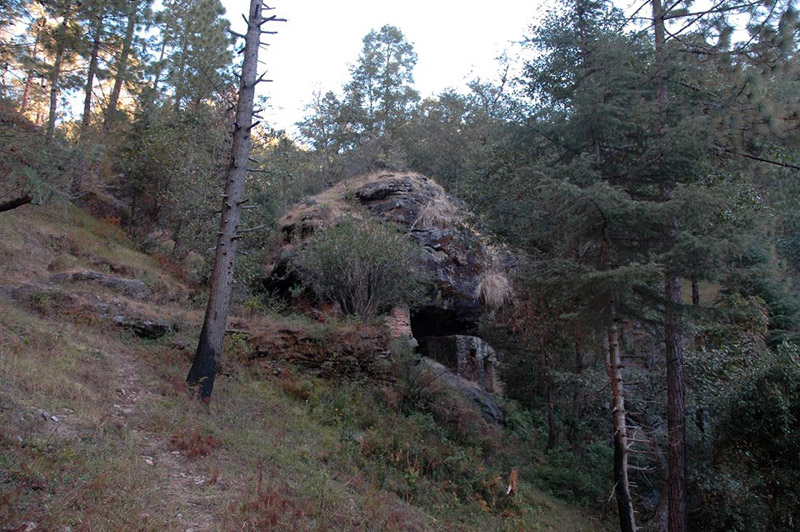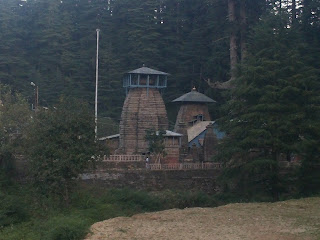Jageshwar
In Uttarakand Almora district around 36km from northeast in Kumaun
regoin the Jageshwar shiva temple is located. It is located at an attitude of 1870mts
in the river valley where two streams Nandini and surabhi flow down from the
hills and meet near the sacred spot. Dedor forest is wondeful with flowing
river in the valley temple adds more beauty.


Steam flowing the valley,Jageshwar Dham.
Village near Jageshwar Dham.




Steam flowing the valley,Jageshwar Dham.
Village near Jageshwar Dham.
The temple is located starting from Artola village on Almora -Pithoragarh Highways.The nearest rail head is Kathgodam 125 km. Jageshwar has direct road links with Almora (35 km), Haldwani (131 km.), Pithoragarh (88 km) and Kathgodam. State transport, and private jeeps and taxis ply from these place for Jageshwar regularly.


Kuber temple Jageshwar.
The temple architecture belongs to Nagara style. The temples have the stone lingams and very impressive stone images around the altar. A carved doorway leads you to the square sanctum sanctorum. There is a tall curvilinear spire shikhara, Surmounted by an amalaka(cap stone) and a kalasha crown. Some ashtadhatu (an alloy of eight metals) images are outstanding. One of the rarest specimens in northern India, the Ekamukhalinga can be seen here.

The temple city comprises a cluster of 124 large and small stone temples, dating 9th to 13th century AD,prerved by ASI, which include
Dandeshwar Temple,
Chandi-ka-Temple,
Jageshwar Temple,
Kuber Temple,
Mritunjaya Temple,
Nanda Devi or Nau Durga,
Nava-grah temple, a Pyramidal shrine, and
Surya Temple,
In that the oldest shrine is the
Mrityunjaya Temple and the biggest shrine is the Dandeshwar Temple.
Stone Carving in temple complex.

A cave near Jageshwar temple.
It is believed that the Nagesh
Jyothilingam. That means one of the twelve joythi lingam establised by
vishnu, among that 8th one is Jageshwar temple. These temple range in the period from
the 8th century(early Ktyuri Dynasty)to the 18th century(chand dynasty).The
temple were renoavted durning the regin of Katyuri king Shalivahandev. There is
an inscription of Malla Kings on the main temple premises indicating their
devotion to Jageshwar. The Katyuri Kings also donated villages to the
temple priests for its maintenance. The Chand Kings of Kumaun were also
patrons of the Jageshwar temple. Numerous Jageshwar
temples were constructed or restored during the Gujara Pratijara era. While leaving from Kendranath Adi Shankarar
renovated and rebuilt the temple.
The pilgrimage to Jageshwar was considered as
sacred as the famous chardham yatra. The temple was construed by stone and
woods.the stone and wood carved wth god and goddess.




The Place
merits mention in the Manas Khand of Skanda Purana. It is believed that Lord
Shiva himself had done tapasya here for untold years and consequently all the
gods and goddesses have done tapasya here, making it a place of powerful divine
energies. It is referred to as Rikheshwar, where rishis have done tapasya.
The Tree at one end of the complex is said to be some 5000years.
The imposing and spectacularly large
devadar tree at one end of the complex is said to be some 5,000 years old. At
the entrance is a Bhairav mandir. On the opposite side, there is also a
sanyasin dhuna. Behind the Jaganath temple, within the complex is the living
siddha samadhi of a Puri sanyasin, where bhog is offered, as at the temples in
the complex. Across the river is a temple dedicated to Kuber, the god of
wealth.
The folklore in the
regions around Jageshwar tells us a gripping story about building the Main
temple Near Kot Linga Temple Complex. Shiva selected this place to be his
abode. During the Tapasya by Shiva, Demons obstruct His penance. Then God
"Sam" come into being as Trinetra and send His Ganas to kill the
demons. It is believed that Sam will come to Kot Linga temple premises to save
humanity and Jageshwar in Kalyuga. Adi Shankacharya tried to build the main
temple at Kotlinga but to no avail as Sam wanted Kotlinga to be specifically
reserved for the meditation of Shiva. Old ruins of a temple structure can be
found near Kotlinga. Local people still believe that Sam or Lakulisha, the Lord
with a stick shall come and built the real Jageshwar temple near Kotlinga and
thus save the mankind from adversities of Kalyuga.
The statue of
Lakulisha; meaning, the Lord with a staff or mace or club or stick; is back at
Jageshwar after almost 50 years. Lakulisha has been stated to have born in
Gujarat and propagated Saivism. The resemblance in kumaoni language and
Gujarati are actually an indication of Lakulisha and his disciples visiting and
influencing people and culture of not only Jageshwar but entire Kumaon region.
Tarun Jageshwar is one of the
principal temples situated in the temple premises. The temple has two
dwarapalas (door guardians) in the form of the armed Nandi and Skandi.
This is a west facing temple of Shiva. Here, Shiva is worshipped in the
form of Nagesh/Jageshwar. In the sanctum sanctorum of the
temple, the Shivlinga is divided into two parts. The larger
one depicts Shiva and smaller one his consort Parvati. An Akhand
Jyoti, (an immortal flame) burns in the temple. There are two Asthadhatu statues
of Chand Kings Deepchand and Tripalchand in the standing posture
behind the Shivlinga.
Sri Mahamritunjaya Mahadev
The Mahamrityunjay
temple is the largest and oldest temple in the Jageshwar temple complex. This
temple of Shiva is eastern facing and the Linga is worshipped as the saviour
from death - महामृत्युंजय. The unique linga has an eye shaped opening.
Pilgrims believe that reciting the Mahamritunjaya Mantra is
a fruitful, auspicious and powerful method of self-realisation, removal of evil
effects, and freedom from all kinds of fears, illness and negativity. The
Mahamritunjaya Mantra is attested in the Sukla Yajurveda Samhita III/60
-
ॐ हौ जूँ सः
ॐ भूर्भुवः स्वः
ॐ त्रयंबकं यजामहे सुगन्धिम् पुष्टिवधर्नम्
उर्वारूकमिव बन्धनान्मृत्यॊर्मुक्षीय मामृतात्
ॐ स्वः भुवः भूः ॐ
सः जूँ हौ ॐ
We pray Lord Shiva,
the All-Seeing One, three eyed, who bears grace of all-pervading divine
fragrance and enricher of all kinds of powers and viguour by His enormous
prosperous bestowals. May He release me from the grip of premature untimely
death, but not from immortality like pumpkin or watermelon separates after
ripening from its vine.
Jhanker Sam Mahadev
This temple is
situated south of Jageshwar. Legend has it that during the Tapasya by
Shiva, Demons obstruct His penance. Then God Jhanker "Sam" come into
being as Trinetra and send His Ganas to kill
the demons. It is believed that Sam will come to Kot Linga temple premises to
save humanity and Jageshwar in Kalyuga.
Kot Ling Mahadev
Kot Ling is Situated
at the "Sangam" of Jata Ganga and Sam Ganga Rivers.As per the local
folk lore, Kot Ling was originally selected as a place by Shiva for meditation.
This place is around 2 km walk from the main temple complex of Jageshwar.
A small mountainous trek leads to this place. Currently this place has ruins of
an Old Shiva Temple
Dandeshwar Shiv temple complex
Situated slightly
upstream from the Jageshwar temple complex, the Dandeshwar temple complex is in
a dilapidated condition. The stone lingam is a natural rock, and, unlike the
lingams of the Jageshwar complex, is not carved.
Vinayak Kshetra
This place is 200 mts
from Artola village from where temples of Jageshwar starts. From this place
Vinayak Kshetra or sacred area begins. This place lies between Jhanker
Saim temple,Vrudhh jageshwar and Koteshwar temples.
Sri Briddha or Bud Jageshwar
This temple is
situated three km north to Jageshwar.This temple is situated at the top of the
hill and comes after an uphill trek. It is contemporary to Jageshwar group of
temples.
Pushti Devi or Pushti Bhagawati Maa
It is the temple of
Goddess Devi. The temple enshrines the full murti of
Goddesses. This temple is situated in the Jageshwar main premises.






During the entire month of Shravan (July-August) there is a fair here and the festival of Shivaratri is celebrated here with piety. At other times, it mostly remains a quiet, sleepy village, hidden from the glare of publicity. The Kalash-Manasarovar Yatra to Tibet, organised by Govt. India, and the Adi Kailash Yatra in pithoragarh, passes through Jageshwar on appointed days from June to Sept.










The Jageshwar Monsoon Festival, during the Hindu month shravan.
-Anbe Sivam.










